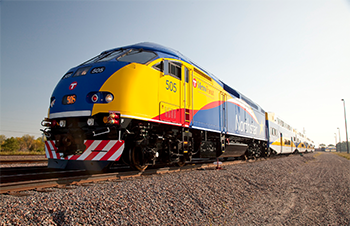Northstar Commuter Rail
 Commuter rail service in the Northstar corridor opened in November 2009 between downtown Minneapolis and the City of Big Lake. From 2011 through 2019, Northstar carried between 2,200 and 3,300 weekday riders during the morning and evening peak commute hours of service. Northstar also featured special event service on evenings and weekends for Minnesota’s Twins, Vikings, and University of Minnesota Gopher sports events.
Commuter rail service in the Northstar corridor opened in November 2009 between downtown Minneapolis and the City of Big Lake. From 2011 through 2019, Northstar carried between 2,200 and 3,300 weekday riders during the morning and evening peak commute hours of service. Northstar also featured special event service on evenings and weekends for Minnesota’s Twins, Vikings, and University of Minnesota Gopher sports events.
The arrival of the COVID-19 pandemic led to a dramatic ridership drop of nearly 98%, just 60 weekday rides in April 2020. In 2021, daily ridership peaked in October at 346 daily rides or just over 13% of the October 2019 pre-pandemic level. In 2022, Northstar carried around 300 daily rides.
Study goals
The Met Council embarked on this study recognizing the Northstar ridership decline and operational challenges brought on and intensified by the COVID-19 pandemic. The study also builds on the work of previous Northstar studies to:
- Assist state and local decision makers to determine a course of action;
- Examine the trade-offs of possible future transit scenarios; and
- Document the potential benefits and opportunities for future transit service in the corridor and compare them against the likely impacts and challenges of implementation
The evaluation results of this project offer context for future decision making for transit service in the Northstar corridor. They are not intended to identify or select a preferred alternative or transit service type.
The Met Council and Metro Transit are committed to working with project partners to identify the transit mode and service level that best meets the needs of Northstar corridor communities, the Twin Cities metropolitan area, and the state of Minnesota.
Peer review
The study reviewed five peer rail corridors in comparison to Northstar commuter rail.
- Downeaster (Portland, Maine to Boston, Intercity/Commuter Rail hybrid service)
- Frontrunner (Salt Lake City, Commuter Rail)
- Sounder (Seattle, Commuter Rail)
- COASTER (San Diego, Commuter Rail)
- Trinity Railway Express (Dallas/Fort Worth, Commuter Rail)
At a high level, this review highlighted generally that in the United States, intercity rail has seen greater recovery in pandemic era than commuter rail service. That said, among its peers, Northstar has lower ridership, but comparable productivity or riders per hour. Northstar has the highest per-passenger subsidy and lowest fare recovery. And, while Northstar has struggled to restore ridership, most rail agencies have restored more service since 2020, and others are looking to expand.
Scenario evaluation
The study evaluated six transit scenarios across three transit modes commuter rail, extended rail, and express bus. Each scenario looked at five factors: ridership, financial performance, accessibility and equity, community development, and environmental sustainability.
- Commuter rail at current service level (4 trips/day + restore special events)
- Commuter rail at pre-Covid service level (12 trips/day + special events)
- Extend rail service to St. Cloud – Base (4 daily trips)
- Extend rail service to St. Cloud – High (9 daily trips)
- Replace rail service with express bus – Base (30-min peak service)
- Replace rail service with express bus – High (15-min peak service)
Pros and cons of each scenario are outlined in the coming report for future consideration. The report is expected to be completed by the end of March 2023.
Staff present the study at the March 13 Transportation Committee.
Next steps
Future decisions on transit service in the Northstar corridor will be based on policy and public input considerations that go beyond the scope of this study.
This study sets the stage for future stakeholder conversations with funding partners, corridor cities and policymakers. It helps frame involvement with the Federal Transit Administration, and collaboration with Federal Railroad Administration and the railroads in the corridor. It may also call for further analysis of customers, travel patterns, schedules, funding and more.